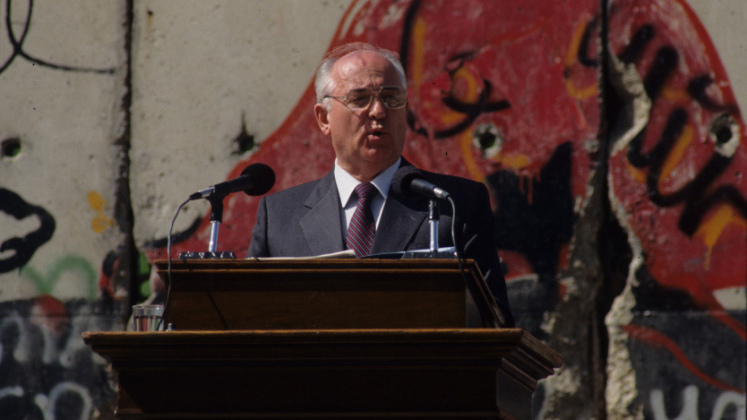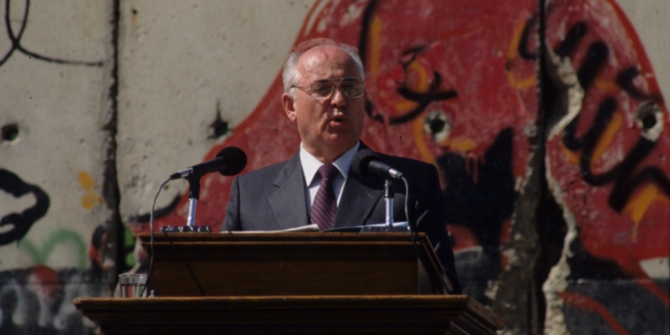In Collapse, Vladislav M. Zubok examines the fall of the Soviet Union, showing how the collapse was not sudden but rather the result of a long decline with economic strains at the centre. This is a compelling and detailed study that will prove to be the new standard work on a critical period in world history that still has ramifications today, writes William B. Whisenhunt.
Collapse: The Fall of the Soviet Union. Vladislav M. Zubok. Yale University Press. 2021.
 The collapse of the Soviet Union in 1991 was once part of current events, but now it is history. The last years of the Soviet Union were tense and controversial. The 1970s and 1980s were defined by the idea of Mutually Assured Destruction (MAD), Cold War movies like The Day After, War Games and Red Dawn, economic stagnation and heated rhetoric from figures like the Soviet Union leader, Yuri Andropov, and US President Ronald Reagan. For those who lived through this era, the dread of apocalyptic disaster was mixed with dark cynicism about the period’s politics.
The collapse of the Soviet Union in 1991 was once part of current events, but now it is history. The last years of the Soviet Union were tense and controversial. The 1970s and 1980s were defined by the idea of Mutually Assured Destruction (MAD), Cold War movies like The Day After, War Games and Red Dawn, economic stagnation and heated rhetoric from figures like the Soviet Union leader, Yuri Andropov, and US President Ronald Reagan. For those who lived through this era, the dread of apocalyptic disaster was mixed with dark cynicism about the period’s politics.
With Collapse, esteemed historian Vladislav M. Zubok has written what will prove to be the new standard work on one of the most dramatic events of the late twentieth century. The collapse of the Soviet Union in late 1991 seemed sudden to the world, and even a bit unbelievable. Yet, Zubok illuminates how the collapse was not so sudden, but rather the result of a long decline.
Zubok’s book takes a novel approach to the subject by focusing on economic strains as the main cause of the collapse. Economic stagnation from the 1960s and 1970s has often been discussed in other works on the last years of the Soviet Union, but Collapse puts that theme front and centre. After reading Zubok’s lengthy study, the economic argument becomes more and more compelling. While traditional interpretations still hold up over time, this work makes it clear that the main strain was economic.
This economic theme falls squarely on the shoulders of the final leader of the Soviet Union, Mikhail Gorbachev. His economic reforms, known as perestroika (‘restructuring’), were slow to develop and did not produce the kind of change that allowed the Soviet economy to modernise. His openness policy, known as glasnost, allowed Soviet citizens to see that world in a new way, but it also exposed a lot of the flaws of the Soviet regime in the past and present. This bred an impatience among Soviet citizens to fulfil the long-held Soviet promise of better living standards, but these did not materialise.

Image Credit: ‘End of Cold War – Mikhail Gobachev Event’ by Photographer/Studio SW licensed by Missouri State Archives, No Known Copyright Restrictions
Zubok’s lengthy and detailed study is easy to read. It is crafted with a strong narrative approach to relate an unfolding drama. This not only keeps the reader’s attention, but also provides a wealth of detail and analysis that can only be undertaken by someone with Zubok’s lifetime of work on the subject.
The first section of the book focuses on the 1980s when the Soviet Union was declining as it went through a series of older and sick leaders before Gorbachev came to power in March 1985. For both the general reader and the specialist, this section is very important. It draws the reader into the details of the drama that shaped not only the internal collapse of the Soviet system, but also outlines how the outside world (especially the United States) played a key part in how this era developed.
In the second section, Zubok emphasises the roles that many Western powers played in the collapse of communism in Eastern Europe in 1989. The intimate details Zubok reveals about the conversations and negotiations that took place between 1989 and 1991 are a treasure in this work and will be used by scholars for years to come.
In particular, the administration of US President George H.W. Bush (1989-93) played a critical part in the unravelling of the Soviet Union with its desire to have it end peacefully rather explode into a regional or international conflict. While the Bush administration was hesitant in the first half of 1989 to engage fully with Gorbachev, it would prove central to the events that led to the dissolution of the Soviet Union in the last months of 1991.
One of the most compelling parts of the books is Zubok’s retelling and analysis of the period between August and December 1991. The details are revealing about the inner workings of the Soviet government in its final days and weeks. The future first President of the Russian Federation, Boris Yeltsin, emerges in this treatment as a pivotal figure who saw the changes that were coming and positioned himself to take advantage of them for his own personal power. Also, hardline communists in the leadership presented roadblocks at nearly every turn to Gorbachev’s reforms that left his attempts at transformation quite anaemic.
Zubok concludes, though, that the real responsibility for the collapse rests on Gorbachev. He introduced radical economic reforms that could not be fulfilled. He stresses that Gorbachev’s inability to adjust to the developing realities during his six years in power helped spread disillusionment with the system itself. Gorbachev’s inspiration for this reform effort was the work of the Soviet founder Vladimir Lenin. However, he only partially embraced Lenin’s tactics to bring about such radical change. Zubok’s conclusion about Gorbachev is telling. He notes that Gorbachev’s ‘messianic idea of a humane socialist society was increasingly detached from the realities of Soviet power and its economy’ (427).
In conclusion, Zubok’s book is an excellent study of this critical period in world history that still has ramifications today. His research and analysis will prove invaluable for scholars and the general public as they attempt to understand the collapse of 1991 and its continuing impact on the present.
- This review first appeared at LSE Review of Books.
- Banner Image Credit: Photo by Tengyart on Unsplash
Please read our comments policy before commenting.
Note: This article gives the views of the author, and not the position of USAPP – American Politics and Policy, nor of the London School of Economics.
Shortened URL for this post: https://bit.ly/3HSPfKn
About the reviewer
William B. Whisenhunt – College of DuPage
William B. Whisenhunt is Professor of History at the College of DuPage in the US. He is author or editor of eight books on Russian history. He is co-managing editor of Journal of Russian American Studies (JRAS) https://journals.ku.edu/jras




